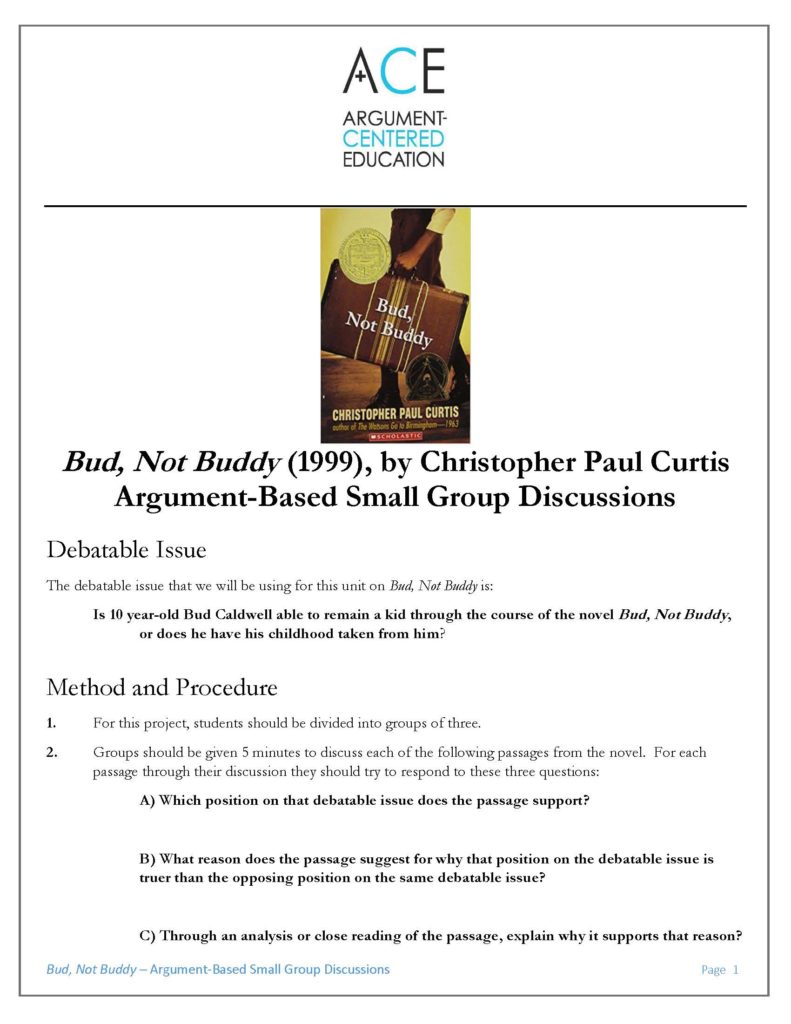
‘Bud, Not Buddy’ and Argument-Based Small Group Discussions Linked to Key Passages
This is the second post on Argument-Centered Education’s newly designed method of organizing teaching and learning around academic argumentation in ELA literature units. The strategy is one we call Argument-Based Discussions Linked to Key Passages. We recently collaborated with ELA teachers with one of our middle school partners to adapt this instructional format to a unit on Christopher Paul Curtis’s Bud, Not Buddy (1999).
Curtis’s book has been awarded with both the Newberry Medal for children’s literature and the Coretta Scott King winner for literature that contributes to bringing about non-violent social change. Bud, Not Buddy is a powerful story of the 10-year old African-American narrator who is an orphan in Flint, Michigan. Taking place in the 1930s, with the Great Depression an important part of the social environment, Bud is shuffled through the foster care system, in search of the care and affection he has lost with the fairly recent death of his mother. His father he comes to believe is a jazz musician who has been playing a regular gig in Grand Rapids. Bud’s journey to find his father has symbolic resonance for a child’s pursuit of security, comfort, and love, in a threatening adult world.
Debatable Issue
The debatable issue that we will be using for this unit on Bud, Not Buddy is:
Is 10 year-old Bud Caldwell able to remain a kid through the course of the novel Bud, Not Buddy, or does he have his childhood taken from him?
Method and Procedure
This will take about three class periods to complete.
(1)
For this project, students should be divided into groups of three.
(2)
Groups should be given 5 minutes to discuss each of the following passages from the novel. For each passage through their discussion they should try to respond to these three questions:
A) Which position on that debatable issue does the passage support?
B) What reason does the passage suggest for why that position on the debatable issue is truer than the opposing position on the same debatable issue?
C) Through an analysis or close reading of the passage, explain why it supports that reason.
(3)
Each student should write out responses to each of the questions on their own form. If there are disagreements during the discussion – which is perfectly fine, and often reflects the kind of independent thinking we are encouraging – students should write out the responses they believe in, noting that group members had a different view. At the end of class, these forms should be collected and formatively assessed.
(4)
After the small group discussion period has ended – and the discussions can be timed fairly closely – the teacher should lead a share-out, asking groups to report back on the responses they feel reflect their best collective thinking, or that featured their strongest internal disagreements. The teacher should ask groups to respond to other groups’ answers, culling out differences, asking how groups would counter or refute an opposing response, and calling on students to evaluate clashing responses. All of this is to build in critical thinking that comes when students engage with each other’s ideas. The key is not to get to a right answer on these passages, but to practice and sharpen students’ interpretive argumentation.
Model
This is a model to project on the board or screen for students. Walk through each response, and check for student understanding on each point.
This was the third foster home I was going to and I’m used to packing up and leaving, but it still surprises me that there are always a few seconds, right after they tell you you’ve got to go, when my nose gets all runny and my throat gets all choky and my eyes get all sting-y (3).
A) This passage supports the position that Bud Caldwell is able to retain his childhood.
B) Bud keeps his emotional sensitivity despite being an orphan and he continues to get sad like a kid would when he is moved around from one foster family to another.
C) Bud acknowledges that his having to move around so much has made him “used to” the process, but his emotions are real and they express themselves each time he has to go to a new foster family. One way to define childhood as distinct from adulthood is that kids are closer to their feelings and freer to express them. Crying becomes an important symbol of feeling sadness, the way that kids can but that some adults (especially men, in our society) often cannot. Bud is telling us early in the novel that he is still capable of being sad and of crying and therefore is still a kid inside, where his emotions are.


